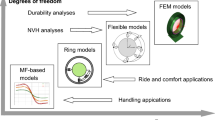Abstract
In this paper, a discrete tire model of cornering properties for road vehicles relating to tire grip performance, which is important for driving stability and safety, is presented. The proposed tire model combines realistic rubber friction related to velocity and tire grip performance with deformation of the carcass. The model can describe the stress and strain of the carcass and tread, and the rubber friction coefficient at each point of the contact patch, which is affected by the distribution of the slip velocity. Meanwhile, the model incorporates the effects of the viscoelastic rubber material and power spectrum of the road, which are explicitly reflected in the rubber friction model. First, an improved rubber friction model based on the Persson theory of rubber friction is introduced in this paper. A discrete analytical tire model, which considers carcass compliance and the discretization of the tread, is then proposed. In addition, important phenomena of tire properties arising from the carcass compliance and rubber friction are analyzed and the effectiveness of the discrete analytical tire model is validated experimentally. The proposed model provides a new way to optimize the grip performance of a tire by adjusting the tire or rubber physical parameters even before the tire is made.

















Similar content being viewed by others
References
Lugner, P.: Vehicle dynamics of modern passenger cars. Springer, Cham (2019)
Pacejka, H.B.: Tire and vehicle dynamics, 3rd edn. Butterworth-Heinemann, Oxford (2012)
Svendenius, J., Gäfvert, M.: A semi-empirical tire model for combined slips including the effects of cambering. Veh. Syst. Dyn. 43(Supp 1), 317–328 (2005)
Pauwelussen, J.P.: The local contact between tyre and road under steady state combined slip conditions. Veh. Syst. Dyn. 41(1), 1–26 (2004)
Henrichmöller, D., Benner, M.: Semi-physical tyre model for real-time capable analysis. ATZ Worldw. 116(6), 8–13 (2014)
Li, B., Yang, X., Yang, J.: Tire model application and parameter identification—a literature review. SAE Int. J. Passeng. Cars Mech. Syst. 7(1), 231–243 (2014)
Sakai, H.: Theoretical and experimental studies on the dynamic properties of tyres: part 3: calculation of the six components of force and moment of a tyre. Int. J. Veh. Des. 2(3), 335–372 (1981)
Gim, G., Nikravesh, P.E.: An analytical model of pneumatic tyres for vehicle dynamic simulations. Part 1 pure slips. Int. J. Veh. Des. 11(6), 589–618 (1990)
Ma, B., Xu, H.G.: Vehicle unsteady dynamics characteristics based on tire and road features. Adv. Mech. Eng. 5(4), 153257 (2013)
Le Gal, A., Guy, L., Orange, G., et al.: Modelling of sliding friction for carbon black and silica filled elastomers on road tracks. Wear 264(7–8), 606–615 (2008)
Persson, B.N.: Rubber friction: role of the flash temperature. J. Phys.: Condens. Matter 18(32), 7789–7823 (2006)
Heinrich, G., Klüppel, M., Vilgis, T.A.: Evaluation of self-affine surfaces and their implication for frictional dynamics as illustrated with a Rouse material. Comput. Theor. Polym. Sci. 10(1–2), 53–61 (2000)
Persson, B.N.: On the theory of rubber friction. Surf. Sci. 401(3), 445–454 (1998)
Selig, M., Lorenz, B., Henrichm, D., et al.: Rubber friction and tire dynamics: a comparison of theory with experimental data. Tire Sci. Technol. 42(4), 216–262 (2014)
De Hoogh, J.: Implementing inflation pressure and velocity effects into the Magic Formula tyre model. Eindhoven University of Technology, Eindhoven (2005)
Pottinger, M.G., Mcintyre, J.E., Kempainen, A.J., et al.: Truck tire force and moment in cornering-braking-driving on ice, snow, and dry surfaces. SAE Trans. 109(2), 629–636 (2000)
Persson, B.N.: Theory of rubber friction and contact mechanics. J. Chem. Phys. 115(8), 3840–3861 (2001)
Westermann, S., Petry, F., Boes, R., et al.: Experimental investigation into the predictive capabilities of modern rubber friction theories. Kautsch. Gummi Kunstst. 57(12), 645–650 (2004)
Klüppel, M., Heinrich, G.: Rubber friction on self-affine road tracks. Rubber Chem. Technol. 73(4), 578–606 (2000)
Le Gal, A., Klüppel, M.: Investigation and modelling of adhesion friction on rough surfaces. Kautsch. Gummi Kunstst. 59(6), 308 (2006)
Grosch, K.A.: Goodyear medalist lecture. Rubber friction and its relation to tire traction. Rubber Chem. Technol. 80(3), 379–411 (2007)
Zegelaar, P.W.A.: The dynamic response of tyres to brake torque variations and road unevennesses. Delft University of Technology, Delft (1998)
Acknowledgements
This research is supported by National Natural Science Foundation of China (Grant Nos. 51875236 and 61790561) and China Automobile Industry Innovation and Development Joint Fund (Grant Nos. U1664257 and U1864206). We would like to gratefully acknowledge and thank the staffs in State Key Laboratory of Automotive Simulation and Control for their contribution to this study.
Author information
Authors and Affiliations
Corresponding author
Ethics declarations
Conflict of interest
On behalf of all authors, the corresponding author states that there is no conflict of interest.
Rights and permissions
About this article
Cite this article
Xu, N., Yang, Y. & Guo, K. A Discrete Tire Model for Cornering Properties Considering Rubber Friction. Automot. Innov. 3, 133–146 (2020). https://doi.org/10.1007/s42154-020-00097-y
Received:
Accepted:
Published:
Issue Date:
DOI: https://doi.org/10.1007/s42154-020-00097-y




